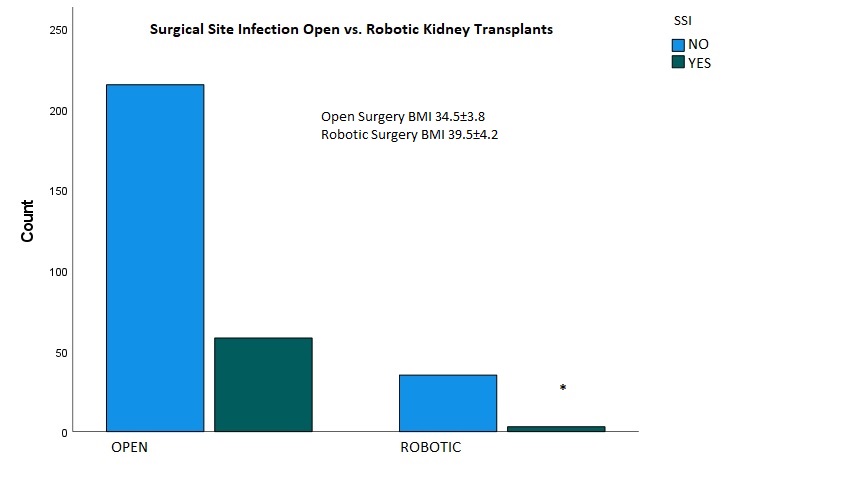Wound Infection After Kidney Transplantation: A Single Center Study
Transplantation, University of Virginia Medical Cener, Charlottesville, VA
Meeting: 2021 American Transplant Congress
Abstract number: 1289
Keywords: Infection, Kidney, Risk factors
Topic: Clinical Science » Organ Inclusive » Surgical Issues (Open, Minimally Invasive):All Organs
Session Information
Session Name: Surgical Issues (Open, Minimally Invasive):All Organs
Session Type: Poster Abstract
Session Date & Time: None. Available on demand.
Location: Virtual
*Purpose: Wound complications (WC) following kidney transplantation (KTx) consume valuable resources and may be associated with inferior short and long term graft outcomes. Known risk factors for WC include immunosuppression(IS) exposure, diabetes(DM), and obesity, as measured by body mass index (BMI). In this study, we sought to identify surgical and non-surgical factors associated with the development of WC following KTx.
*Methods: 741 consecutive patients received KTx at a single center over a 6 year period and were retrospectively reviewed. Combined transplantations and children (< age 18) were excluded. Recipients were classified based on BMI at the time of transplantation: underweight (BMI < 20 kg/m2), normal weight (20 ≤ BMI < 25), overweight (25 ≤ BMI < 30), class I obese (30 ≤ BMI < 35), class II obese (35 ≤ BMI < 40) and class III obese (BMI ≥ 40). The analysis included wound (superficial or deep) or organ space infection and its association with age, gender, HLA mismatch, cold ischemic time, hypertension, DM, delay graft function and surgical technique (open versus robotic transplant(RT)). Statistical analysis was performed by SPSS and significance was set at p<0.05. All patients received a single dose of pre-operative antibiotic prophylaxis and thymoglobulin for induction (3-6 mg/kg). IS was administered based on transplant center protocol and maintenance IS consisted of prednisone, prograf and mycophenolate.
*Results: Thirteen percent (94/741) of patients developed a post-transplant WC (28±16 days postop), 46% (43/94) of these were superficial-incisional and 54% (51/94) were deep-incisional or organ-space. The average BMI among cohort patients was 29.2 and 42% (311/741) were obese (BMI > 30) (table) Patients who developed WC had a greater mean BMI (31.4 vs 29.4, p =0.004) and were more likely to have a history of DM (33 vs. 49%, p<0.05). RT recipients (n=39, mean BMI 39.5±4.2) showed significantly lower WC rates compared to the whole study group and group with BMI over 30(mean BMI 34±3.8) (p<0.00).
*Conclusions: We identified higher BMI and DM as a risk factor for the development of WC following renal transplantation. RT was successful at lowering the higher WC infection rate in diabetic and high BMI patients.
To cite this abstract in AMA style:
Demirag A, Oberholzer J, Agarwal A, Rawashdeh B, McCraken E, Brayman K. Wound Infection After Kidney Transplantation: A Single Center Study [abstract]. Am J Transplant. 2021; 21 (suppl 3). https://atcmeetingabstracts.com/abstract/wound-infection-after-kidney-transplantation-a-single-center-study/. Accessed December 26, 2025.« Back to 2021 American Transplant Congress


